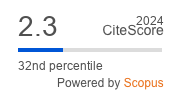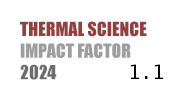THERMAL SCIENCE
International Scientific Journal
PERFORMANCE ANALYSIS ON OPERATION OF DAYTIME GRATING SELECTIVE PASSIVE SKY RADIATIVE COOLING SYSTEM IN BUILDING
ABSTRACT
Passive sky radiative cooling technology has attracted recent interest due to achieve sub-ambient cooling with the advantages of not consuming additional energy and not producing pollutants. However, the practical utility of sky radiative cooling technology in building applications remains under-explored, which requires not only the rational design and integration of the system, but also different control strategies. A novel grating selective passive sky radiative cooling (GS-PSRC) system for building cooling was constructed and five control strategies were used to simulate and analyses the operation of a 50 m2 office building located in Chengdu area during the hottest week of summer in this work. The study shown that the system is able to maintain the average indoor temperature around 20°C during the hottest period and achieve a temperature difference ranging from 3.39-10.77°C, which provides a good cooling capacity. But the excessive outdoor wind speed inhibits the cooling capacity of the GS-PSRC system, which leads to the lower average COP of the system in summer. Its application was further studied across various climate zones. Results indicated the cooling performance of the system mainly be affected by wind speed in different climate zones. Adding wind-blocking devices around radiators is recommended to improve cooling efficiency. This work fully demonstrates the potential application of passive sky radiative cooling technology in building energy efficiency.
KEYWORDS
PAPER SUBMITTED: 2024-07-22
PAPER REVISED: 2025-01-01
PAPER ACCEPTED: 2025-01-10
PUBLISHED ONLINE: 2025-04-13
THERMAL SCIENCE YEAR
2025, VOLUME
29, ISSUE
Issue 3, PAGES [2451 - 2464]
- Goldstein, E. A., et al., Sub-Ambient Non-Evaporative Fluid Cooling with The Sky, Nature Energy, 2 (2017), 17143
- Liu, J., et al., Advances and Challenges in Commercializing Radiative Cooling, Materials Today Physics, 11 (2019), 100161
- Liu, J., et al., Recent Advances in the Development of Radiative Sky Cooling Inspired from Solar Thermal Harvesting, NanoEnergy, 81 (2020), 105611
- Shi, J., et al., Electrocaloric Cooling Materials and Devices for Zero-Global-Warming-Potential, High-Efficiency Refrigeration, Joule, 3 (2019), 5, pp. 1200-1225
- Singh, G. K., Solar Power Generation by PV (photovoltaic) Technology: A Review, Energy, 53 (2013), May, pp. 1-13
- Singh, V. K., Singal, S. K., Operation of Hydro Power Plants - A Review, Renewable & Sustainable Energy Reviews, 69 (2017), Mar., pp. 610-619
- Vargas, S. A., et al., Wind Power Generation: A Review and a Research Agenda, Journal of Cleaner Production, 218 (2019), May, pp. 850-870
- Raman, A. P., et al., Passive Radiative Cooling Below Ambient Air Temperature under Direct Sunlight, Nature, 515 (2014), 7528, pp. 540-544
- Hsu, P. C., et al., Radiative Human Body Cooling by Nanoporous Polyethylene Textile, Science, 353 (2016), 6303, p. 1019-1023
- Zhai, Y., et al., Scalable-Manufactured Randomized Glass-Polymer Hybrid Metamaterial for Daytime Radiative Cooling, Science, 355 (2017), 6329, pp. 1062-1006
- Mandal, J., et al., Hierarchically Porous Polymer Coatings for Highly Efficient Passive Daytime Radiative Cooling, Science, 362 (2018), 6412, pp. 315-319
- Li, T., et al., A Radiative Cooling Structural Material, Science, 364 (2019), 6442, pp. 760-763
- Zeng, S., et al., Hierarchical-Morphology Metafabric for Scalable Passive Daytime Radiative Cooling, Science, 373 (2021), 6555, pp. 692-696
- Wang, S., et al., Scalable Thermochromic Smart Windows with Passive Radiative Cooling Regulation, Science, 374 (2021), 6574, pp. 1501-1504
- Pirvaram, A., et al., Radiative Cooling for Buildings: A Review of Techno-Enviro-Economics and Life-Cycle Assessment Methods, Renewable and Sustainable Energy Reviews, 162 (2022), 112415
- Zhang, J., et al., Cover Shields for sub-Ambient Radiative Cooling: A Literature Review, Renewable and Sustainable Energy Reviews, 143 (2021), 323, 110959
- Lin, K. T., et al., Radiative Cooling: Fundamental Physics, Atmospheric Influences, Materials and Structural Engineering, Applications and Beyond, NanoEnergy, 80 (2020), 105517
- Yu, X., et al., Review of Radiative Cooling Materials: Performance Evaluation and Design Approaches, NanoEnergy, 88 (2021), 106259
- Wu, Y., et al., A Review of the Application of Radiative Sky Cooling in Buildings: Challenges and Optimization, Energy Conversion & Management, 265 (2022), 115768
- Catalanotti, S., The Radiative Cooling of Selective Surfaces, Sol. Energy, 17 (1975), 2, pp. 83-89
- Sun, K., et al., VO2 Thermochromic Metamaterial-Based Smart Optical Solar Reflector, ACS Photonics, 5 (2018), 6, pp. 2280-2286
- Zhou, L., et al., Flexible Polymer Photonic Films With Embedded Microvoids For High-Performance Passive Daytime Radiative Cooling, ACS Photonics, 2021 (2021), 8, pp. 3301-3307
- Jaramillo-Fernandez, J., et al., Highly-Scattering Cellulose-Based LMS for Radiative Cooling, Advanced Science, 9 (2022), 8, 2104758
- Zhang, Y., et al., Atmospheric Water Harvesting by Large-Scale Radiative Cooling Cellulose-Based Fabric, Nanoletters, 22 (2022), 7, pp. 2618-2626
- Herve, A., et al., Radiative Cooling by Tailoring Surfaces with Microstructures: Association of a Grating and a Multi-Layer Structure, J. of Quantitative Spectroscopy and Rad. Transf., 221 (2018), 1, pp. 155-163
- Dai, Y. D., et al., Radiative Cooling with Multilayered Periodic Grating under Sunlight, Optics Communications, 475 (2020), 15, 126231
- Zhang, Z., et al., Design of Selectively Multilayered Periodic Gratings by PSO Algorithm for Radiative Cooling, Optics Communications, 500 (2021), 127323
- Zhang, Z., et al., Passive Radiative Cooling Design with Novel Selectively Grating Structure under Direct Sunlight, Optik, 277 (2023), 170711
- Zhu, B., et al., Subambient Daytime Radiative Cooling Textile Based on Nanoprocessed Silk, Nature Nanotechnology, 16 (2021), 12, pp. 1342-1348
- Liu, Y., et al., Acrylic Membrane Doped with Al2O3 Nanoparticle Resonators for Zero-Energy Consuming Radiative Cooling, Solar Energy Materials and Solar Cells, 213 (2020), 110561
- Yoon, T. Y., et al., Colloidal Deposition of Colored Daytime Radiative Cooling Films Using Nanoparticle-Based Inks, Materials Today Physics, 21 (2021), 100510
- Yin Baoquan, W. Y., et al., Performance Analysis of Multifunctional Building Energy System Based on Photovoltaic Radiation Panels, Sichuan Building Science, 1 (2014), 40, pp. 327-330
- Zhao, D., et al., Roof-Integrated Radiative Air-Cooling System to Achieve Cooler Attic for Building Energy Saving, Energy and Buildings, 203 (2019), 109453
- Zhao, D., et al., Subambient Cooling of Water: Toward Real-World Applications of Daytime Radiative Cooling, Joule, 3 (2018), 1, pp. 111-123
- Aili, A., et al., A kW-Scale 24-hour Continuously Operational Radiative Sky Cooling System Experimental Demonstration and Predictive Modelling, Energy Conversion and Management, 186 (2019), pp. 586-596
- Zhou, K., et al., Performance Analysis on System-Level Integration and Operation of Daytime Radiative Cooling Technology for Air-Conditioning in Buildings, Energy and Buildings, 235 (2021), 4, 110749
- Chen, L., et al., Sub-Ambient Radiative Cooling and Its Application in Buildings, Building Simulation, 13 (2020), 6, pp. 1165-1189
- Jeong, S. Y., et al., A Numerical Study of Daytime Passive Radiative Coolers for Space Cooling in Buildings, Building Simulation, 11 (2018), 005, pp. 1011-1028
- Zhang, et al., Energy Saving and Economic Analysis of a New Hybrid Radiative Cooling System for Single-Family Houses in the USA, Applied Energy, 224 (2018), 815, pp. 371-381
- Wang, W., et al., Performance Assessment of a Photonic Radiative Cooling System for Office Buildings, Renewable Energy, 118 (2018), Apr., pp. 265-277
- Zhao, D., et al., Radiative Sky Cooling-Assisted Thermoelectric Cooling System for Building Applications, Energy, 190 (2020), 116322
- Liao, T., et al., Radiative Cooling-Assisted Thermoelectric Refrigeration and Power Systems: Coupling Properties and Parametric Optimization, Energy, 242 (2022), 122546
- Yin, X., et al., Terrestrial Radiative Cooling: Using the Cold Universe as a Renewable and Sustainable Energy Source, Science, 370 (2020), 6518, pp. 786-791
- Granqvist, G. C., Radiative Cooling to Low Temperatures: General Considerations and Application Selectively Emitting SiO Films, Journal of Applied Physics, 52 (1981), 6, pp. 4205-4220
- Shen, S. S., et al., MODTRAN5: 2006 Update, Proceedings, Algorithms and Technologies for Multispectral, Hyperspectral, and Ultraspectral Imagery XII, Orlando, Fla., USA, 2006, Vol. 6233
- Holman, J. P., Heat Transfer, McGraw-Hill, New York, USA, 6th ed., 2001
- Chae, D., et al., Spectrally Selective Inorganic-Based Multilayer Emitter for Daytime Radiative Cooling, ACS Applied Materials & Interfaces, 12 (2020), 7, pp. 8073-8081

